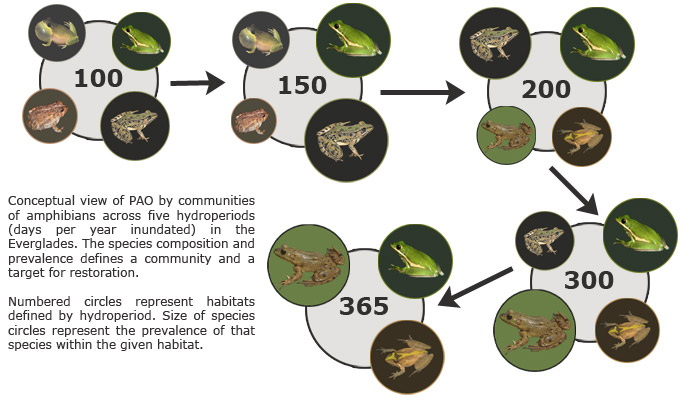Amphibian Communities as Indicators of Restoration Success in the Greater Everglades Ecosystem
Authors
Amanda N. Rice, J. Hardin Waddle, Valerie M. Johnson, Kenneth G. Rice, Frank J. Mazzotti
Amphibians as Indicators
- Through system-wide monitoring, Everglades amphibian communities can act as sentinels of ecosystem health as well as indicators of restoration success.
- We show that hydropattern can shape amphibian communities in the Everglades.
- We can observe differences in community structure across the current hydrologic gradient and infer historic conditions using hydrologic modeling tools such as the Natural Systems Model.
- For example, we can describe the past or future of a community with a restored, longer hydroperiod in one portion of the Everglades by observing the present community of similar hydroperiod, vegetation, elevation, etc. in another portion of the Everglades.
- Observed changes in community structure due to the hydrologic gradient include both changes in species composition (from toad to aquatic salamander dominated communities) and occupancy rates (10% to 90% by any species).
Changes in hydrology will dramatically affect amphibian community composition

Image credit: Everglades Plan
Conceptual Models Using Amphibian Communities to Measure Ecosystem Restoration
*The following model is an example and is not the ultimate restoration goal

Conceptual Models Showing Amphibian Communities Over Different Hydroperiods

Site Occupancy Analysis
We used site occupancy model of MacKenzie et al. (2002) to analyze data. This model estimates sampling occasion specific detection probabilities for each species using maximum likelihood. By estimating detection probabilities, we are able to estimate the site occupancy rate of each species by hydrology.
PAO
A method for estimating Proportion of Area (or sites) Occupied when detection probabilities for a species are less than 1. When applied to randomly chosen sites in a defined area, model output can be used to represent an estimate of PAO by a species.
Why Use PAO?
- Accounts for detection probability.
- Produces estimate of actual site occupancy WITH a confidence interval.
- Inexpensive: requires only presence/absence data.
- Accepted by ARMI (Amphibian Research and Monitoring Initiative) for long-term monitoring on DOI lands.
- The outcome of this research will be community profiles relating the PAO of several key amphibian species to the ecological community along hydrologic gradient.
Implications
Current observations of community structure and descriptions of historic and restored conditions can be used to establish restoration targets for (and monitoring restoration effects on) amphibian communities in the Everglades.
Monitoring of species presence and occupancy on a 3 to 5-year basis should be sufficient to detect changes such as colonization or local extinction of species in the amphibian community due to restoration.
References
MacKenzie, D. I., J. D. Nichols, G. B. Lachman, S. Droege, J. A. Royle, and C. A. Langtimm. 2002. Estimating site occupancy rates when detection probabilities are less than one. Ecology 83(8) 2248-2255.
Citation
Rice, A.N., J.H. Waddle, Valerie M. Johnson K.G. Rice, and F.J. Mazzotti. (2006, June). Amphibian Communities as Indicators of Restoration Success in the Greater Everglades Ecosystem. Poster presented at the Greater Everglades Ecosystem Restoration Conference, Orlando, Florida.




